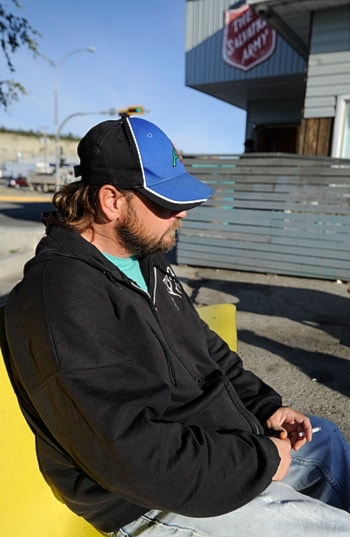With last week’s announcement of nearly $1.8 million coming from the federal government to combat homelessness in the territory, the Yukon Anti-Poverty Coalition says it’s time to restructure the way we think about the issue.
The money, which is being administered by the Council of Yukon First Nations, will be spread out over five years.
Though the federal government is encouraging a “Housing First” approach, it’s ultimately up to each First Nation to decide how and where the money will be spent.
A Housing First approach is rooted in the idea that individuals suffering from addictions or battling mental health issues will be more likely to connect with supports if their basic needs are being met.
A two-year study by the Mental Health Commission of Canada found it to be cost effective; for every $10 invested, the government recouped an average of $27.72 in savings through reduced demand for social programs, emergency shelters and hospital visits.
The approach, while championed by most social groups, hasn’t gained much traction in the Yukon government.
Kate Mechan, project manager with the Yukon Anti-Poverty Coalition, says the language of Housing First is complex and often misunderstood.
The main premise of Housing First is not that taxpayers pay to subsidize people to drink or continue a certain lifestyle, but that individuals aren’t required to engage in treatment or medication regiments from the outset to be housed - the housing is a starting point or gateway to support systems, said Mechan.
So far, few details about how the government will spend the money are available, other than statements about conducting further studies.
The Yukon Anti-Poverty Coalition says there’s no need for further number crunching and that anecdotal evidence is widely available, one just has to look out on the streets.
In 2010, a housing adequacy study produced in partnership with Health and Social Services found that more than 100 individuals identified at the time of that survey didn’t have anywhere to stay.
“We know there’s at least that many people,” said Mechan. “We know it’s not going to be any less than that number. What needs to be addressed in Whitehorse, and rural communities, is a lack of infrastructure.”
Knowing that a sum of $1.8 million is not going to achieve that, the coalition is hoping the money will be used for prevention work, such as a crisis prevention fund, and funneled into long-term solutions.
The current approach to homelessness in the territory is a crisis-based model, or emergency solutions, said Mechan.
“We don’t tend to focus on the idea that we can end homelessness. We don’t need to reinvent the wheel here, there’s all kinds of things happening in other jurisdictions that are similar to ours. Its just getting the right heads in the room and getting a buy-in from our leaders.”
Data collection, the coalition says, is a slippery slope that can lead to much-needed funding evaporating quickly.
The waiting list at the Salvation Army shelter is further evidence, said Mechan.
“The data is there. We have a place to start. We don’t need to not build more housing just because we think we don’t know the numbers - we do.
“It’s really a manageable number. We’re not in Vancouver, we’re not talking thousands of people. We’re talking about a few handfuls of marginalized people that needed support yesterday.”
Mechan believes a better understanding of how individuals end up homeless will help progress the conversation.
She highlights three areas: structural factors, such as lack of affordable housing or discrimination; systemic failures, such as when an individual is transitioned out of the child welfare system into homelessness or individuals are discharged from hospitals or corrections centers without adequate planning for the next step; and individual circumstance, such as job loss, family violence, mental health, addictions or another disability.
The standard approach to homelessness puts the onus on individual circumstance, followed by structural factors and then systemic failures.
Mechan says a shift in thinking is needed to address structural factors first.
“It doesn’t have to be about blaming a particular minister or a particular person. It’s just about saying we haven’t been doing good enough and what can we change - how can we work with what we have now, in the interim? How can we meet people’s needs better?”
Mechan said, ultimately, it boils down to community health.
“If we don’t address the way systems aren’t working we’re never going to get anywhere. It doesn’t do anybody good to blame a person because they have an addiction or because they have a mental health issue.”
To do that, hard conversations need to happen, and the coalition says they are ready to take that step.
“We’re really keen to bring people to the table and have some conversations in an open and transparent way. There’s room to make decisions about infrastructure needs now. We don’t need to wait five years to make these decisions.”
An interview request to the Council of Yukon First Nations was not returned by deadline.
Contact Sam Riches at sam@yukon-news.com
